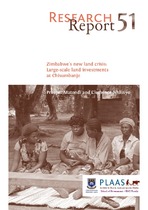| dc.contributor.author | Matondi, Prosper | |
| dc.contributor.author | Nhliziyo, Clemence | |
| dc.date.accessioned | 2019-03-13T12:19:45Z | |
| dc.date.available | 2019-03-13T12:19:45Z | |
| dc.date.issued | 2015 | |
| dc.identifier.citation | Matondi, P. et al. (2015). Zimbabwe's new land crisis: Large-scale land investments at Chisumbanje. Research Report 51. Institute for Poverty, Land and Agrarian Studies, University of the Western Cape | en_US |
| dc.identifier.uri | http://hdl.handle.net/10566/4503 | |
| dc.description.abstract | Zimbabwe’s investments in agriculture, after a
contested Fast Track Land Reform Programme
(FTLRP) underpinned by often violent land
occupations (these were largely contained by
the state by 2005), have triggered a debate
on the meaning and import of ‘international
land grabs’ (Matondi 2015). Internationally,
the debates have been increasing, with the
drive towards the cultivation of feedstock for
the production of renewable fuel being one
driving force. The mandatory blending of biofuels
in national fuel stocks has been accepted
and today 62 countries have introduced mandatory
blending, with South Africa introducing
a target of 2% blending in October 2014.
It is in respect of the emerging trends that
we sought to decipher the meaning of ‘land
grabs’, ‘international land grabs’ and ‘agricultural
investments’ as these mean different
things in different contexts. | en_US |
| dc.language.iso | en | en_US |
| dc.publisher | Institute for Poverty, Land and Agrarian Studies, University of the Western Cape | en_US |
| dc.relation.ispartofseries | Research Report;51 | |
| dc.subject | Zimbabwe | en_US |
| dc.subject | Land crisis | en_US |
| dc.subject | Land investments | en_US |
| dc.subject | Chisumbanje | en_US |
| dc.subject | Land reform | en_US |
| dc.title | Zimbabwe's new land crisis: Large-scale land investments at Chisumbanje | en_US |
| dc.type | Other | en_US |

